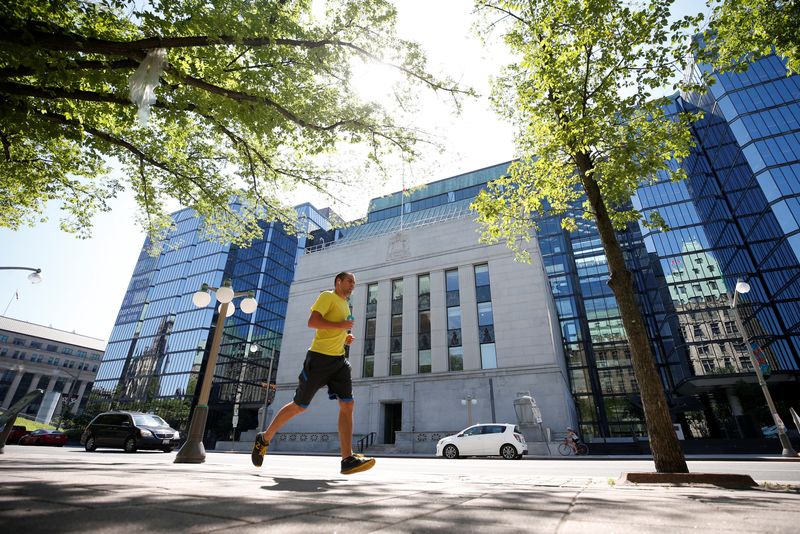
© Reuters. FILE PHOTO: A jogger runs past the Bank of Canada building in Ottawa, Ontario, Canada, July 11, 2018. REUTERS/Chris Wattie
By Steve Scherer and David Ljunggren
OTTAWA (Reuters) -The Bank of Canada was concerned about inflation sticking above its 2% target and agreed there might be a need to tighten monetary policy further when officials decided to leave rates on hold this month.
On March 8, the bank became the first major central bank to pause its tightening campaign, leaving the key overnight interest rate on hold at 4.50%.
All five members of the governing council all agreed to keep rates on hold to measure the effects of previous rate hikes because “the economy is slowing, and inflation is coming down”, according to minutes from the policy-setting meeting released on Wednesday.
The central bank vowed to hold off on further hikes as long as inflation continued to ease in line with its forecasts.
In January the bank said it expected inflation to ease to 3% at around mid-year and to slow to 2% next year. But during deliberations ahead of the announcement, the bank noted that services inflation “is proving sticky”.
The governing council remains “concerned about the risk that inflation could get stuck materially above the 2% target,” the minutes said.
Over the past year, the bank raised rates eight times in a row by a total of 425 basis points to tame inflation, which peaked at an annualized rate of 8.1% last year and slowed to 5.2% in February.
“After increasing the policy rate at each of the last eight decisions, Governing Council saw the pause as an opportunity to learn whether interest rates had increased enough to return inflation to the 2% target,” the minutes said.
The council operates on a consensus basis and does not vote on policy decisions.
“The Bank still needs to see more evidence of lower inflation expectations and weaker wage pressures before it can rule out raising interest rates further,” said Stephen Brown, deputy chief North America economist for Capital Economics, in a note.
The situation has changed markedly since March 8. Bank failures in the United States and Europe show that pushing up rates too high could fuel further financial instability, and underpin a continued pause on rates in Canada.
On March 8, money markets were betting that the Bank of Canada’s next move would be another rate increase by September. Now they are betting there will be a cut by July.
The Federal Reserve on Wednesday raised interest rates by a quarter of a percentage point, but indicated it was on the verge of pausing further increases in borrowing costs amid recent turmoil in financial markets spurred by the collapse of two U.S. banks.
Just two weeks ago when the Canadian central bank met, they discussed “whether the resilience of the U.S. economy to higher interest rates and the persistence of elevated core inflation foreshadowed similar developments in Canada”, according to the minutes.
Source: Investing.com




























